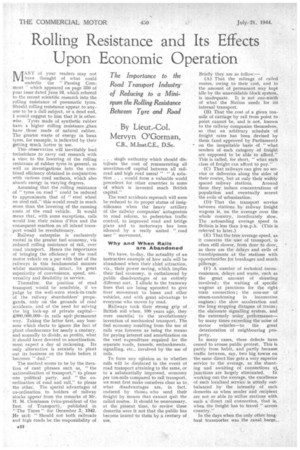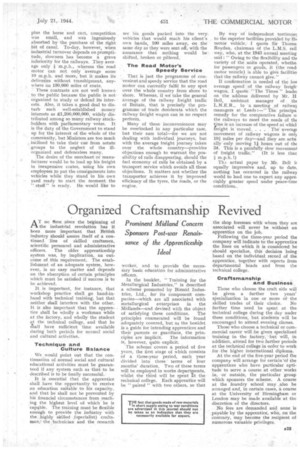Rolling Resistance and Its Effects Upon Economic Operation
Page 24

Page 25

If you've noticed an error in this article please click here to report it so we can fix it.
The Importance to the Road Transport Industry
of Reducing to a MinirFum the Rolling Resistance Between Tyre and Road
By Lieut.-Col, Mervyn O'Gorman,
CB., M.Inst.C.E., D.Sc.
MANY of your readers may not have thought of what could underlie the " Passing Comment " which appeared on page 350 of your issue dated June 16, which referred
to the recent scientific research into the rolling resistance of pneumatic tyres. Should rolling resistance appear to any one to be a dull subject, or a dead end,
would suggest to him that it is otherwise. Tyres made of synthetic rubber' have a higher rolling resistance athan have . those made of natural rubber.. The greater waste of energy in bona tyres, for example, is indicated by their getting much hotter in use.
This observation will inevitably lead technicians to carry out research with a view, to the lowering of the rolling resistance of rubber tyres in general, as well as investigations into the com bined efficiency obtained in conjunction with various road surfaces, which also absorb energy in varying degrees.
Assuming that the rolling resistance of " tyres on road " could be reduced to approximate that of " steel wheel on steel rail," this would result in much more than the lowering of the running costs of the road vehicle. It would mean that, with some exceptions, rails would lose .their raison d'être and the consequent reaction on all inland transport would be revolutionary.
Railway enterprise is exclusively rooted in the greater fuel economy, via reduced rolling resistance of rail, over road transport. Hence the importance of bringing the efficiency of the road motor vehicle on a-par with that of the railways in this fundamental manner whilst maintaining, intact, its great superiority of convenience, speed, universality and flexibility in service.
Thereafter; the position of road 'transport would be assailable, if we judge by the well-worn stock-in-trade of the railway shareholders' propaganda, only on the grounds of road accidents, and of the need for salving the big lock-up of private capital£800,000,000—in rails and• permanent way. Taking the latter first, any business which elects to ignore the fact of plant obsolescence for nearly a century, and annually to divide, as profits, what it should have devoted to amortization, must expect a day of reckoning. Its only alternative is astutely to plant out its business on the State before it becomes " dud." .
The method seems to be by the iteration of cant phrases such as, " the nationalization of transport." to please one political party, and "the co-ordination of road and rail," to please the other. The special advantages of co-ordination to holders of railway stocks appear from the remarks of Mr.
H. M. Cleminson (vice-president of the
Inst. of Transport), published in "-The Times " for December 3,. 1042.
He said: " Should not both railroads and high roads be the responsibility of
. A22.
. single authority which should distribute the cost of remunerating all unwritten-off capital between all railroad and high road users? " " A solution . . would form a valuable world precedent for other countries in some of which is invested much British capital."
The road accidents reproach will soon be reduced to its proper status of insignificance w-hen the heavy artillery of the railway companies' antagonism to road reform, to pedestrian traffic control, to improved road and bridge plans and to motorways has been silenced by a really united " road user " movement.
Why and When Rails are Abandoned
We have, to-day, the actuality of an instructive example of how rails will be abandoned when their chief attraction, viz., their. power saving, which implies their fuel economy, is outbalanced by public disadvantages of an entirely different sort. I allude to the tramway lines that are being uprooted to .give freer movement to buses and other vehicles, and with great advantage to everyone who moves by road.
Railways took their strong grip of British soil when, 100 years ago, they were essential to the revolutionary invention of mechanical transport. The fuel economy resulting from the use. of rails was foreseen as being the means for paying interest and amortization on the vast'expenditure required for the separate roads, tunnels, embankments, signalling, etc., involved by the use of rails.
To form any opinion as to whether. rails will be displaced in the event of road transport attaining to the same, or to a substantially improved, economy per ton-mile compared to rail transport, we must first make ourselves clear as to, what disadvantages are, in fact, endured by those » who send their freight by means that cannot quit .the railed routes. It should be unnecessary, at the Present time to review these demerits were it not that the public has become inured to them by a century of use. Briefly they are as follow:
-(A) That the mileage of railed routes, owing to their cost, and to the amount of permanent way kept idle by the unavoidable block system, is inadequate. It is not one-ninth of what the Nation needs for its internal -transport.
(B) That the cost of a given tonmile of carriage by rail from point to point cannot be, and is not, known to the railway companies themselves, so that an arbitrary schedule of freight rates has been devised by them (and approved by Parliament) on the inequitable basis of " what senders of each category of freightare supposed to be able to afford." This is called, for short, " what each class of freight can afford to pay."
(C) That railways can give no service or deliveries along the sides of their. routes, but at only their widely spaced railway stations. Around these they induce concentrations of population and eventually accent the evils of urbanization.
(D) That the transport service between stations by railway freight wagons is, on the average over the whole country, inordinately slow. The astounding average speed in Britain is less than t-m.p.h. (This is referred to later.)
(E) That the true average speed, as it concerns the user of transport, is often still slower, from door to door, as there are the delays and evils of transhipments at the stations with opportunities for breakages and much pilferage,
(E) A number of technical ilICAUveniences, delays and waste, such as the great amount of shunting involved;' the waiting of specific wagOns at junctions for the right train connection ; the non-use of steam-condensing in locomotive engines ; the slow acceleration and the long stopping distance of trains; the elaborate signalling system, and the extremely noisy performance— by many times exceeding the noise of motor vehicles—to the great deterioration of neighbouring property.
In many cases, these defects have ceased to arouse public protest. This is partly from habit, and partly because traffic between, say, two big towns on -the same direct line gets a very superior service to the average, as the shunting and awaiting of connections at
junctions are largely eliminated. In working out the average, the excellence of such localized service is utterly outbalanced by the intensity of such demerits as when sender and recipient are not so able to utilize stations with such adirect rail connection, that is, when the freight has to travel " ,cross country,'"
In the days when the only. other longhaul transporter was the canal barge,,,
plus the horse and cart, competition was small, and was ingeniously absorbed by the purchase of the right bit of canal. To-day, however, when industrial turnover depends on promptitude, slowness has become a grave inferiority for the railways. They average only 4 'm.p.h., whereas the road motor can not only -average some 10 m.p.h. and more, but it makes its deliveries without transhipment, anywhere on 180,000 miles of route.
• These contrasts are not well known to the public because the public is not. organized to study or defend its interests. Also, it takes a good deal to disturb such well-established money interests as £1,200,000,000, widely distributed among so many railway stockholders with parliamentary votes. It is the duty of the Government to stand up for the interest of the whole of the community, but Ministers are too much inclined to take their cue from astute groups to the neglect of the illorganized and defenceless many.
The desire of the merchant or manufacturer would be to load up his freight in inexpensive crates, using his own employees to put the consignments into vehicles while they stand in his own yard ready to start the moment the " stuff" is ready, He would like to see his goods packed into the very vehicles that would reach his client's own hands, 100 miles away, on the same day as they were sent off, with the assurance that nothing would be shifted, broken or. pilfered.
The Road Motor's Speedy Service • That is just the programme of convenient and speedy service that the road motor can currently fulfil :to any spot over the whole country from shore to shore. Whereas, if w6 take the general average of the railway freight traffic of Britain, that is precisely the programme of trade desiderata which the railway freight wagon can in no respect perform.
Many of these inconveniences may be overlooked in any particular case, but their sum total—for we are not dealing with individual journeys, but with the average freight journey taken over the whole country—provides objections enough to warrant the possibility of rails disappearing, should the fuel economy of rails be obtained by a transport service which avoids all these objections. It matters not whether the transporter achieves it by improved efficiency of the tyres, the roads, or the engine. By way of independent testimony to the superior facilities provided by thi motor vehicle,. I quote Sir Thoma! Royden, chairman of the L.M.S. rail way, who, at the 1943 annual meeting said : "Owing to the flexibility and the variety of the units operated, whethe. for passengers or goods, it (the road. motor vehicle) is able to give facilitie: that the railway cannot give."
If confirmation is needed of the lcei average speed of the railway freighi wagon, I quote "The Times " leado on the address delivered by Mr. H Bell, assistant manager of .the L.N.E.R., to a meeting of railway managers at Leeds :—" The principa remedy for the comparative failure o: the railways to meet the needs of the tine is an increase of the speed at whicl freight is moved.. . . . The average movement of railway wagons is only 104 miles per day-and they are actu. ally only moving 14 hours out of the 24. This is a painfully slow movemeni
of freight traffic." (It is less that m.p.h. !) Th.: actual paper by Mr. Bell is equally impressive and, up to date, nothing has occurred in the railway world to lead one to expect any appreeia,bly greater speed under peace-time conditions.




















































